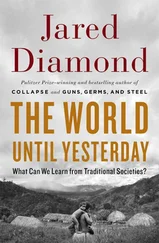Jared Diamond - Guns, Germs & Steel
Здесь есть возможность читать онлайн «Jared Diamond - Guns, Germs & Steel» весь текст электронной книги совершенно бесплатно (целиком полную версию без сокращений). В некоторых случаях можно слушать аудио, скачать через торрент в формате fb2 и присутствует краткое содержание. Жанр: 105. Описание произведения, (предисловие) а так же отзывы посетителей доступны на портале библиотеки ЛибКат.
- Название:Guns, Germs & Steel
- Автор:
- Жанр:
- Год:неизвестен
- ISBN:нет данных
- Рейтинг книги:5 / 5. Голосов: 1
-
Избранное:Добавить в избранное
- Отзывы:
-
Ваша оценка:
- 100
- 1
- 2
- 3
- 4
- 5
Guns, Germs & Steel: краткое содержание, описание и аннотация
Предлагаем к чтению аннотацию, описание, краткое содержание или предисловие (зависит от того, что написал сам автор книги «Guns, Germs & Steel»). Если вы не нашли необходимую информацию о книге — напишите в комментариях, мы постараемся отыскать её.
Guns, Germs & Steel — читать онлайн бесплатно полную книгу (весь текст) целиком
Ниже представлен текст книги, разбитый по страницам. Система сохранения места последней прочитанной страницы, позволяет с удобством читать онлайн бесплатно книгу «Guns, Germs & Steel», без необходимости каждый раз заново искать на чём Вы остановились. Поставьте закладку, и сможете в любой момент перейти на страницу, на которой закончили чтение.
Интервал:
Закладка:
The near-simultaneous disappearance of so many large species raises an obvious question: what caused it? An obvious possible answer is that they were killed off or else eliminated indirectly by the first arriving humans. Recall that Australian/New Guinean animals had evolved for millions of years in the absence of human hunters. We know that Galapagos and Antarctic birds and mammals, which similarly evolved in the absence of humans and did not see humans until modern times, are still incurably tame today. They would have been exterminated if conservationists had not imposed protective measures quickly. On other recently discovered islands where protective measures did not go into effect quickly, exterminations did indeed result: one such victim, the dodo of Mauritius, has become virtually a symbol for extinction. We also know now that, on every one of the well-studied oceanic islands colonized in the prehistoric era, human colonization led to an extinction spasm whose victims included the moas of New Zealand, the giant lemurs of Madagascar, and the big flightless geese of Hawaii. Just as modern humans walked up to unafraid dodos and island seals and killed them, prehistoric humans presumably walked up to unafraid moas and giant lemurs and killed them too.
Hence one hypothesis for the demise of Australia's and New Guinea's giants is that they met the same fate around 40,000 years ago. In contrast, most big mammals of Africa and Eurasia survived into modern times, because they had coevolved with protohumans for hundreds of thousands or millions of years. They thereby enjoyed ample time to evolve a fear of humans, as our ancestors' initially poor hunting skills slowly improved. The dodo, moas, and perhaps the giants of Australia/New Guinea had the misfortune suddenly to be confronted, without any evolutionary preparation, by invading modern humans possessing fully developed hunting skills.
However, the overkill hypothesis, as it is termed, has not gone unchallenged for Australia/New Guinea. Critics emphasize that, as yet, no one has documented the bones of an extinct Australian/New Guinean giant with compelling evidence of its having been killed by humans, or even of its having lived in association with humans. Defenders of the overkill hypothesis reply: you would hardly expect to find kill sites if the extermination was completed very quickly and long ago, such as within a few millennia some 40,000 years ago. The critics respond with a countertheory: perhaps the giants succumbed instead to a change in climate, such as a severe drought on the already chronically dry Australian continent. The debate goes on.
Personally, I can't fathom why Australia's giants should have survived innumerable droughts in their tens of millions of years of Australian history, and then have chosen to drop dead almost simultaneously (at least on a time scale of millions of years) precisely and just coincidentally when the first humans arrived. The giants became extinct not only in dry central Australia but also in drenching wet New Guinea and southeastern Australia. They became extinct in every habitat without exception, from deserts to cold rain forest and tropical rain forest. Hence it seems to me most likely that the giants were indeed exterminated by humans, both directly (by being killed for food) and indirectly (as the result of fires and habitat modification caused by humans). But regardless of whether the overkill hypothesis or the climate hypothesis proves correct, the disappearance of all of the big animals of Australia/New Guinea had, as we shall see, heavy consequences for subsequent human history. Those extinctions eliminated all the large wild animals that might otherwise have been candidates for domestication, and left native Australians and New Guineans with not a single native domestic animal.
Thus, the colonization of Australia/New Guinea was not achieved until around the time of the Great Leap Forward. Another extension of human range that soon followed was the one into the coldest parts of Eurasia. While Neanderthals lived in glacial times and were adapted to the cold, they penetrated no farther north than northern Germany and Kiev. That's not surprising, since Neanderthals apparently lacked needles, sewn clothing, warm houses, and other technology essential to survival in the coldest climates. Anatomically modern peoples who did possess such technology had expanded into Siberia by around 20,000 years ago (there are the usual much older disputed claims). That expansion may have been responsible for the extinction of Eurasia's woolly mammoth and woolly rhinoceros.
With the settlement of Australia/New Guinea, humans now occupied three of the five habitable continents. (Throughout this book, I count Eurasia as a single continent, and I omit Antarctica because it was not reached by humans until the 19th century and has never had any self-supporting human population.) That left only two continents, North America and South America. They were surely the last ones settled, for the obvious reason that reaching the Americas from the Old World required either boats (for which there is no evidence even in Indonesia until 40,000 years ago and none in Europe until much later) in order to cross by sea, or else it required the occupation of Siberia (unoccupied until about 20,000 years ago) in order to cross the Bering land bridge. However, it is uncertain when, between about 14,000 and 35,000 years ago, the Americas were first colonized. The oldest unquestioned human remains in the Americas are at sites in Alaska dated around 12,000 B.C., followed by a profusion of sites in the United States south of the Canadian border and in Mexico in the centuries just before 11,000 B.C. The latter sites are called Clovis sites, named after the type site near the town of Clovis, New Mexico, where their characteristic large stone spearpoints were first recognized. Hundreds of Clovis sites are now known, blanketing all 48 of the lower U.S. states south into Mexico. Unquestioned evidence of human presence appears soon thereafter in Amazonia and in Patagonia. These facts suggest the interpretation that Clovis sites document the Americas' first colonization by people, who quickly multiplied, expanded, and filled the two continents.
One might at first be surprised that Clovis descendants could reach Patagonia, lying 8,000 miles south of the U.S.-Canada border, in less than a thousand years. However, that translates into an average expansion of only 8 miles per year, a trivial feat for a hunter-gatherer likely to cover that distance even within a single day's normal foraging.
One might also at first be surprised that the Americas evidently filled up with humans so quickly that people were motivated to keep spreading south toward Patagonia. That population growth also proves unsurprising when one stops to consider the actual numbers. If the Americas eventually came to hold hunter-gatherers at an average population density of somewhat under one person per square mile (a high value for modern hunter-gatherers), then the whole area of the Americas would eventually have held about 10 million hunter-gatherers. But even if the initial colonists had consisted of only 100 people and their numbers had increased at a rate of only 1.1 percent per year, the colonists' descendants would have reached that population ceiling of 10 million people within a thousand years. A population growth rate of 1.1 percent per year is again trivial: rates as high as 3.4 percent per year have been observed in modern times when people colonized virgin lands, such as when the HMS Bounty mutineers and their Tahitian wives colonized Pitcairn Island.
The profusion of Clovis hunters' sites within the first few centuries after their arrival resembles the site profusion documented archaeologically for the more recent discovery of New Zealand by ancestral Maori. A profusion of early sites is also documented for the much older colonization of Europe by anatomically modern humans, and for the occupation of Australia/New Guinea. That is, everything about the Clovis phenomenon and its spread through the Americas corresponds to findings for other, unquestioned virgin-land colonizations in history.
What might be the significance of Clovis sites' bursting forth in the centuries just before 11,000 B.C., rather than in those before 16,000 or 21,000 B.C.? Recall that Siberia has always been cold, and that a continuous ice sheet stretched as an impassable barrier across the whole width of Canada during much of the Pleistocene Ice Ages. We have already seen that the technology required for coping with extreme cold did not emerge until after anatomically modern humans invaded Europe around 40,000 years ago, and that people did not colonize Siberia until 20,000 years later. Eventually, those early Siberians crossed to Alaska, either by sea across the Bering Strait (only 50 miles wide even today) or else on foot at glacial times when Bering Strait was dry land. The Bering land bridge, during its millennia of intermittent existence, would have been up to a thousand miles wide, covered by open tundra, and easily traversable by people adapted to cold conditions. The land bridge was flooded and became a strait again most recently when sea level rose after around 14,000 B.C. Whether those early Siberians walked or paddled to Alaska, the earliest secure evidence of human presence in Alaska dates from around 12,000 B.C.
Soon thereafter, a north-south ice-free corridor opened in the Canadian ice sheet, permitting the first Alaskans to pass through and come out into the Great Plains around the site of the modern Canadian city of Edmonton. That removed the last serious barrier between Alaska and Patagonia for modern humans. The Edmonton pioneers would have found the Great Plains teeming with game. They would have thrived, increased in numbers, and gradually spread south to occupy the whole hemisphere.
One other feature of the Clovis phenomenon fits our expectations for the first human presence south of the Canadian ice sheet. Like Australia/New Guinea, the Americas had originally been full of big mammals. About 15,000 years ago, the American West looked much as Africa's Serengeti Plains do today, with herds of elephants and horses pursued by lions and cheetahs, and joined by members of such exotic species as camels and giant ground sloths. Just as in Australia/New Guinea, in the Americas most of those large mammals became extinct. Whereas the extinctions took place probably before 30,000 years ago in Australia, they occurred around 17,000 to 12,000 years ago in the Americas. For those extinct American mammals whose bones are available in greatest abundance and have been dated especially accurately, one can pinpoint the extinctions as having occurred around 11,000 B.C. Perhaps the two most accurately dated extinctions are those of the Shasta ground sloth and Harrington's mountain goat in the Grand Canyon area; both of those populations disappeared within a century or two of 11,100 B.C. Whether coincidentally or not, that date is identical, within experimental error, to the date of Clovis hunters' arrival in the Grand Canyon area.
The discovery of numerous skeletons of mammoths with Clovis spearpoints between their ribs suggests that this agreement of dates is not a coincidence. Hunters expanding southward through the Americas, encountering big animals that had never seen humans before, may have found those American animals easy to kill and may have exterminated them. A countertheory is that America's big mammals instead became extinct because of climate changes at the end of the last Ice Age, which (to confuse the interpretation for modern paleontologists) also happened around 11,000 B.C.
Personally, I have the same problem with a climatic theory of megafaunal extinction in the Americas as with such a theory in Australia/New Guinea. The Americas' big animals had already survived the ends of 22 previous Ice Ages. Why did most of them pick the 23rd to expire in concert, in the presence of all those supposedly harmless humans? Why did they disappear in all habitats, not only in habitats that contracted but also in ones that greatly expanded at the end of the last Ice Age? Hence I suspect that Clovis hunters did it, but the debate remains unresolved. Whichever theory proves correct, most large wild mammal species that might otherwise have later been domesticated by Native Americans were thereby removed.
Also unresolved is the question whether Clovis hunters really were the first Americans. As always happens whenever anyone claims the first anything, claims of discoveries of pre-Clovis human sites in the Americas are constantly being advanced. Every year, a few of those new claims really do appear convincing and exciting when initially announced. Then the inevitable problems of interpretation arise. Were the reported tools at the site really tools made by humans, or just natural rock shapes? Are the reported radiocarbon dates really correct, and not invalidated by any of the numerous difficulties that can plague radiocarbon dating? If the dates are correct, are they really associated with human products, rather than just being a 15,000-year-old lump of charcoal lying next to a stone tool actually made 9,000 years ago?
To illustrate these problems, consider the following typical example of an often quoted pre-Clovis claim. At a Brazilian rock shelter named Pedro Furada, archaeologists found cave paintings undoubtedly made by humans. They also discovered, among the piles of stones at the base of a cliff, some stones whose shapes suggested the possibility of their being crude tools. In addition, they came upon supposed hearths, whose burnt charcoal yielded radiocarbon dates of around 35,000 years ago. Articles on Pedro Furada were accepted for publication in the prestigious and highly selective international scientific journal Nature.
But none of those rocks at the base of the cliff is an obviously human-made tool, as are Clovis points and Cro-Magnon tools. If hundreds of thousands of rocks fall from a high cliff over the course of tens of thousands of years, many of them will become chipped and broken when they hit the rocks below, and some will come to resemble crude tools chipped and broken by humans. In western Europe and elsewhere in Amazonia, archaeologists have radiocarbon-dated the actual pigments used in cave paintings, but that was not done at Pedro Furada. Forest fires occur frequently in the vicinity and produce charcoal that is regularly swept into caves by wind and streams. No evidence links the 35,000-year-old charcoal to the undoubted cave paintings at Pedro Furada. Although the original excavators remain convinced, a team of archaeologists who were not involved in the excavation but receptive to pre-Clovis claims recently visited the site and came away unconvinced.
The North American site that currently enjoys the strongest credentials as a possible pre-Clovis site is Meadowcroft rock shelter, in Pennsylvania, yielding reported human-associated radiocarbon dates of about 16,000 years ago. At Meadowcroft no archaeologist denies that many human artifacts do occur in many carefully excavated layers. But the oldest radiocarbon dates don't make sense, because the plant and animal species associated with them are species living in Pennsylvania in recent times of mild climates, rather than species expected for the glacial times of 16,000 years ago. Hence one has to suspect that the charcoal samples dated from the oldest human occupation levels consist of post-Clovis charcoal infiltrated with older carbon. The strongest pre-Clovis candidate in South America is the Monte Verde site, in southern Chile, dated to at least 15,000 years ago. It too now seems convincing to many archaeologists, but caution is warranted in view of all the previous disillusionments.
If there really were pre-Clovis people in the Americas, why is it still so hard to prove that they existed? Archaeologists have excavated hundreds of American sites unequivocally dating to between 2000 and 11,000 B.C., including dozens of Clovis sites in the North American West, rock shelters in the Appalachians, and sites in coastal California. Below all the archaeological layers with undoubted human presence, at many of those same sites, deeper older layers have been excavated and still yield undoubted remains of animals-but with no further evidence of humans. The weaknesses in pre-Clovis evidence in the Americas contrast with the strength of the evidence in Europe, where hundreds of sites attest to the presence of modern humans long before Clovis hunters appeared in the Americas around 11,000 B.C. Even more striking is the evidence from Australia/New Guinea, where there are barely one-tenth as many archaeologists as in the United States alone, but where those few archaeologists have nevertheless discovered over a hundred unequivocal pre-Clovis sites scattered over the whole continent.
Early humans certainly didn't fly by helicopter from Alaska to Meadowcroft and Monte Verde, skipping all the landscape in between. Advocates of pre-Clovis settlement suggest that, for thousands or even tens of thousands of years, pre-Clovis humans remained at low population densities or poorly visible archaeologically, for unknown reasons unprecedented elsewhere in the world. I find that suggestion infinitely more implausible than the suggestion that Monte Verde and Meadowcroft will eventually be reinterpreted, as have other claimed pre-Clovis sites. My feeling is that, if there really had been pre-Clovis settlement in the Americas, it would have become obvious at many locations by now, and we would not still be arguing. However, archaeologists remain divided on these questions.
The consequences for our understanding of later American prehistory remain the same, whichever interpretation proves correct. Either: the Americas were first settled around 11,000 B.C. and quickly filled up with people. Or else: the first settlement occurred somewhat earlier (most advocates of pre-Clovis settlement would suggest by 15,000 or 20,000 years ago, possibly 30,000 years ago, and few would seriously claim earlier); but those pre-Clovis settlers remained few in numbers, or inconspicuous, or had little impact, until around 11,000 B.C. In either case, of the five habitable continents, North America and South America are the ones with the shortest human prehistories.
With the occupation of the Americas, most habitable areas of the continents and continental islands, plus oceanic islands from Indonesia to east of New Guinea, supported humans. The settlement of the world's remaining islands was not completed until modern times: Mediterranean islands such as Crete, Cyprus, Corsica, and Sardinia between about 8500 and 4000 B.C.; Caribbean islands beginning around 4000 B.C.; Polynesian and Micronesian islands between 1200 B.C. and A.D. 1000; Madagascar sometime between A.D. 300 and 800; and Iceland in the ninth century A.D. Native Americans, possibly ancestral to the modern Inuit, spread throughout the High Arctic around 2000 B.C. That left, as the sole uninhabited areas awaiting European explorers over the last 700 years, only the most remote islands of the Atlantic and Indian Oceans (such as the Azores and Seychelles), plus Antarctica.
What significance, if any, do the continents' differing dates of settlement have for subsequent history? Suppose that a time machine could have transported an archaeologist back in time, for a world tour at around 11,000 B.C. Given the state of the world then, could the archaeologist have predicted the sequence in which human societies on the various continents would develop guns, germs, and steel, and thus predicted the state of the world today?
Our archaeologist might have considered the possible advantages of a head start. If that counted for anything, then Africa enjoyed an enormous advantage: at least 5 million more years of separate protohuman existence than on any other continent. In addition, if it is true that modern humans arose in Africa around 100,000 years ago and spread to other continents, that would have wiped out any advantages accumulated elsewhere in the meantime and given Africans a new head start. Furthermore, human genetic diversity is highest in Africa; perhaps more-diverse humans would collectively produce more-diverse inventions.
But our archaeologist might then reflect: what, really, does a "head start" mean for the purposes of this book? We cannot take the metaphor of a footrace literally. If by head start you mean the time required to populate a continent after the arrival of the first few pioneering colonists, that time is relatively brief: for example, less than 1,000 years to fill up even the whole New World. If by head start you instead mean the time required to adapt to local conditions, I grant that some extreme environments did take time: for instance, 9,000 years to occupy the High Arctic after the occupation of the rest of North America. But people would have explored and adapted to most other areas quickly, once modern human inventiveness had developed. For example, after the ancestors of the Maori reached New Zealand, it apparently took them barely a century to discover all worthwhile stone sources; only a few more centuries to kill every last moa in some of the world's most rugged terrain; and only a few centuries to differentiate into a range of diverse societies, from that of coastal hunter-gatherers to that of farmers practicing new types of food storage.
Our archaeologist might therefore look at the Americas and conclude that Africans, despite their apparently enormous head start, would have been overtaken by the earliest Americans within at most a millennium. Thereafter, the Americas' greater area (50 percent greater than Africa's) and much greater environmental diversity would have given the advantage to Native Americans over Africans.
The archaeologist might then turn to Eurasia and reason as follows. Eurasia is the world's largest continent. It has been occupied for longer than any other continent except Africa. Africa's long occupation before the colonization of Eurasia a million years ago might have counted for nothing anyway, because protohumans were at such a primitive stage then. Our archaeologist might look at the Upper Paleolithic flowering of southwestern Europe between 20,000 and 12,000 years ago, with all those famous artworks and complex tools, and wonder whether Eurasia was already getting a head start then, at least locally.
Finally, the archaeologist would turn to Australia/New Guinea, noting first its small area (it's the smallest continent), the large fraction of it covered by desert capable of supporting few humans, the continent's isolation, and its later occupation than that of Africa and Eurasia. All that might lead the archaeologist to predict slow development in Australia/New Guinea.
But remember that Australians and New Guineans had by far the earliest watercraft in the world. They were creating cave paintings apparently at least as early as the Cro-Magnons in Europe. Jonathan Kingdon and Tim Flannery have noted that the colonization of Australia/New Guinea from the islands of the Asian continental shelf required humans to learn to deal with the new environments they encountered on the islands of central Indonesia-a maze of coastlines offering the richest marine resources, coral reefs, and mangroves in the world. As the colonists crossed the straits separating each Indonesian island from the next one to the east, they adapted anew, filled up that next island, and went on to colonize the next island again. It was a hitherto unprecedented golden age of successive human population explosions. Perhaps those cycles of colonization, adaptation, and population explosion were what selected for the Great Leap Forward, which then diffused back westward to Eurasia and Africa. If this scenario is correct, then Australia/New Guinea gained a massive head start that might have continued to propel human development there long after the Great Leap Forward.
Thus, an observer transported back in time to 11,000 B.C. could not have predicted on which continent human societies would develop most quickly, but could have made a strong case for any of the continents. With hindsight, of course, we know that Eurasia was the one. But it turns out that the actual reasons behind the more rapid development of Eurasian societies were not at all the straightforward ones that our imaginary archaeologist of 11,000 B.C. guessed. The remainder of this book consists of a quest to discover those real reasons.
Читать дальше
Интервал:
Закладка:
Похожие книги на «Guns, Germs & Steel»
Представляем Вашему вниманию похожие книги на «Guns, Germs & Steel» списком для выбора. Мы отобрали схожую по названию и смыслу литературу в надежде предоставить читателям больше вариантов отыскать новые, интересные, ещё непрочитанные произведения.
Обсуждение, отзывы о книге «Guns, Germs & Steel» и просто собственные мнения читателей. Оставьте ваши комментарии, напишите, что Вы думаете о произведении, его смысле или главных героях. Укажите что конкретно понравилось, а что нет, и почему Вы так считаете.










